Turtle Talk, by Walt Anderson
It’s time to talk turtle! There are about 360 living species of turtles in the world, about 3% of reptilian diversity. Arizona is a herpetologist’s paradise when it comes to reptiles (impressive lizard and rattlesnake diversity, for example), though only 6 of the 107 native reptiles in the state are turtles. General aridity, of course, doesn’t favor aquatic animals, and our half-dozen native turtles include two (Desert Tortoise and Ornate Box Turtle) that are terrestrial, though the latter will take a dip now and then.
The turtles we see most often in Arizona are non-native, and it’s these I will use to illustrate my turtle talk. They will serve to stand in for the order as a whole and will also exemplify the hazards of introduced species, a concern right up there with climate change.
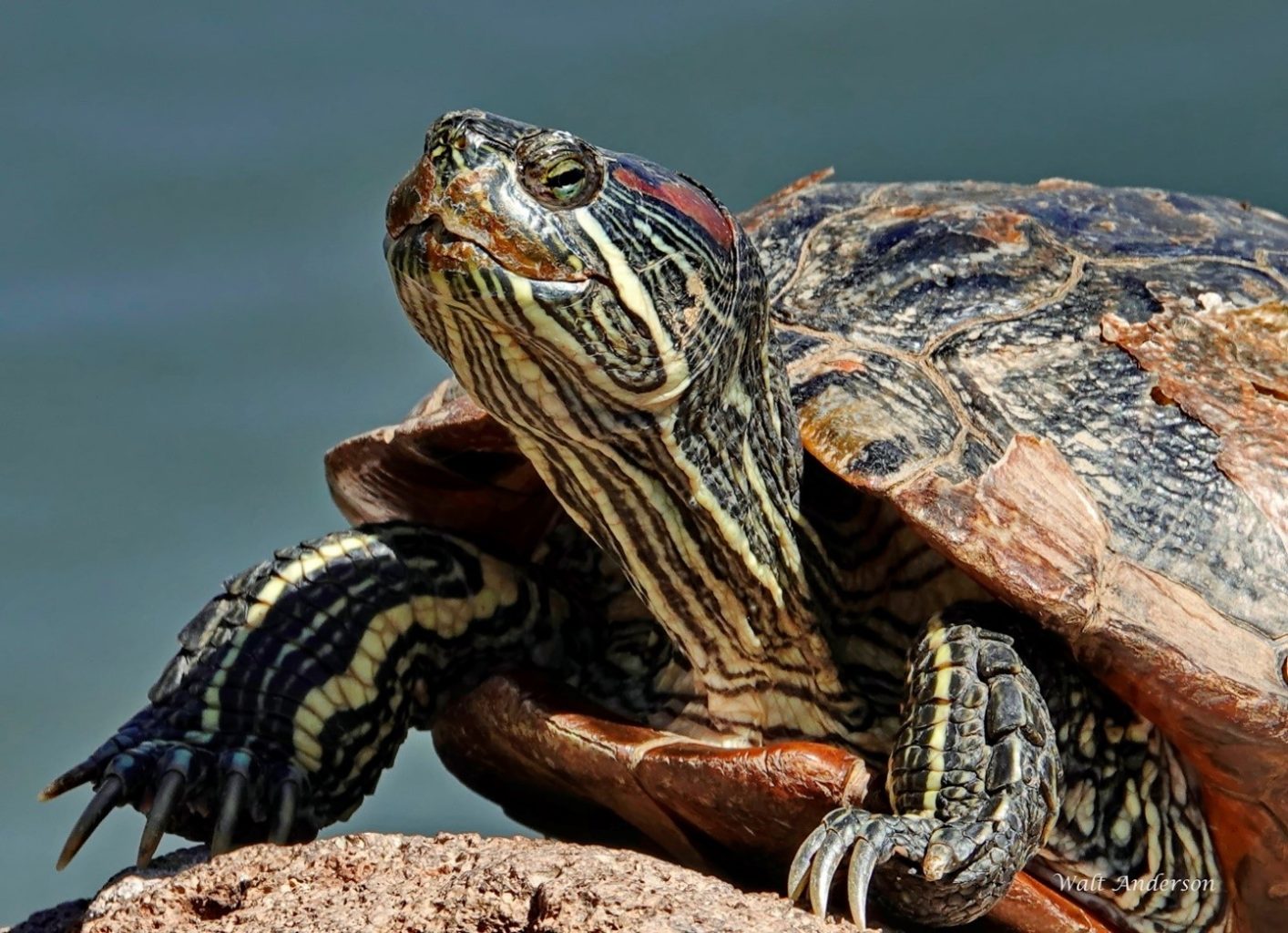
If you google “sliders,” you may end up with images of mini-burgers like you might find as bar food (a.k.a., barf food). But to a naturalist, the first thing that comes to mind is the Red-eared Slider, the most popular reptile sold as pets in the world. When I was a child, every pet store had dozens of cute little baby turtles, and many a happy child brought them home to love them to death, as most kids simply don’t understand turtle biology. Some of the little turtles turned the tables; as carriers of salmonella bacteria, they often sickened and even killed those turtle-loving tykes. In 1975, the sale of baby sliders was banned in the US. Pet stores now can only sell sliders 4 inches in diameter or larger. US breeders also sent them around the world in the international pet trade, creating ecological havoc in the process. Between 1989 and 1997, the US exported over 52 million around the world!
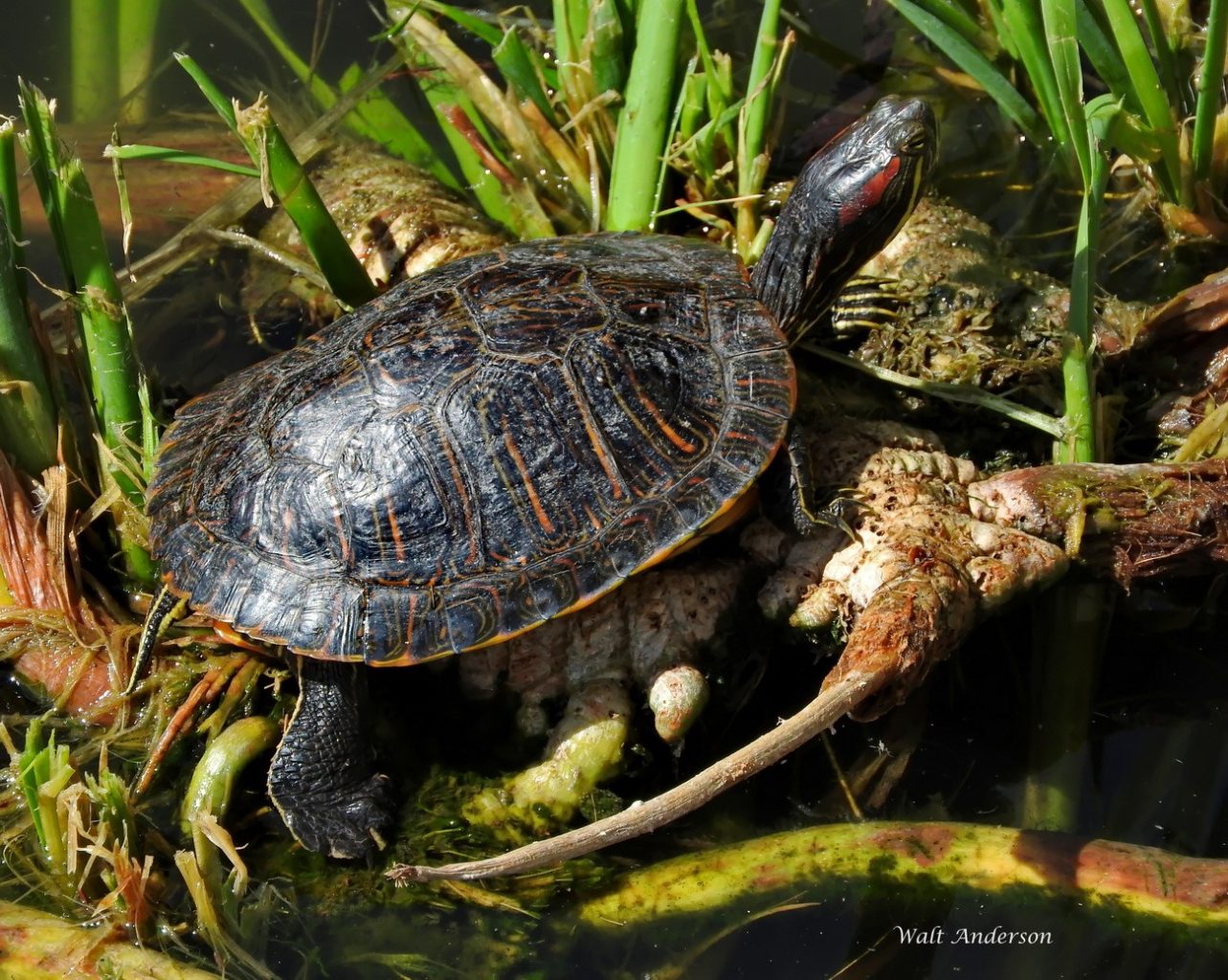
Native to the lower Midwest and the Gulf Coast states other than Florida, Red-eared Sliders used humans as dispersal agents to get around the world, where they now bear the dubious distinction of “the world’s most invasive turtle.” It’s not their fault, of course, but in the wrong places, they can outcompete or otherwise harm the native turtles, frogs, fish, and other aquatic critters. They also constitute a health hazard by harboring salmonella. Australia and India are just two of the countries that have serious problems with introduced sliders. They have become common in water bodies in Tucson, Phoenix, Yuma, Prescott, the Verde Valley, and elsewhere in Arizona. The Phoenix Zoo has become an unofficial dumping ground for people’s unwanted pets despite signs and warnings for the public to cease and desist. In the past 20 years, zoo officials have captured over a thousand turtles of about 20 species (remember—only 6 native species in Arizona). Who knows how many turtles have been dumped into canals, city parks, marshes, and other wetlands around the state? Teenage Mutant Ninja Turtles were based on Red-eared Sliders, and that phenomenon just added to the pet turtle problem. As turtles grow, they become “stinky and bitey,” as one observer noted. Turtles are not affectionate pets in the first place, nor are they amusingly playful. The “logical” thing for a jaded pet owner to do is to let the turtles go somewhere (thereby passing the problem off on someone else, including Ma Nature herself).

Red-eared Sliders swim by pushing backward with opposite front and back feet, then alternating with the other feet. For example, it’s thrust with left front and right rear, then right front and left rear. As reptiles, they have lungs, though they can also respire through their skin, throat linings, and thin-walled sacs in their cloacas (the common urogenital openings). They are amazingly tolerant of low oxygen levels, even getting by under completely anaerobic conditions, as when they hang out on the bottom for weeks at a time while “brumating” (similar to hibernating), reducing their heart rate by 80%. The low-energy lifestyle is adaptive for a “cold-blooded” animal (people who murder them are cold-blooded killers).

Because their body temperatures depend on the external environment, they often climb out of the water to bask in the sun, even piling up on one another if necessary to secure a basking position. They are alert to potential trouble, however, and slide off into the water (perhaps why they are called “sliders”) when people or other potential hazards approach.
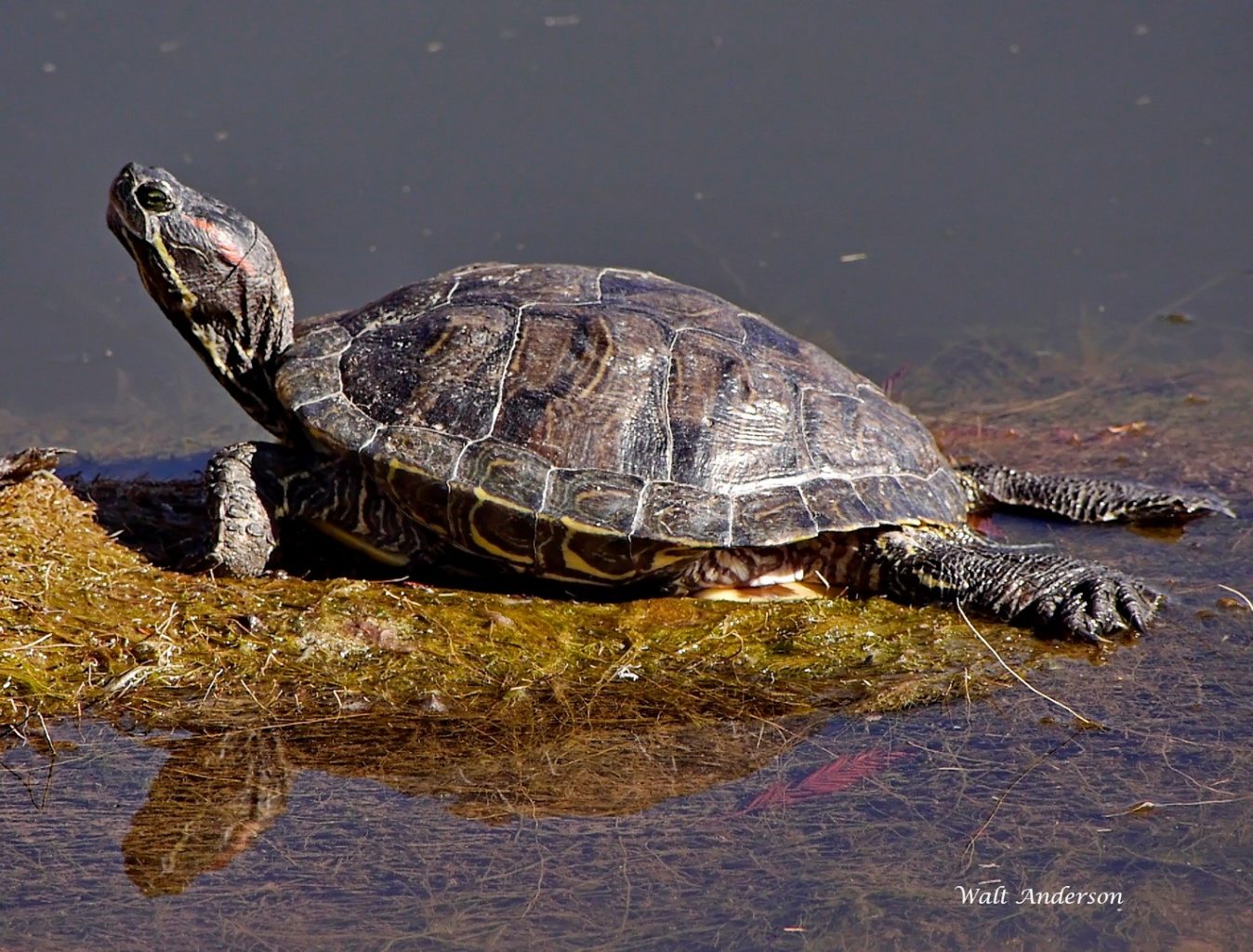
The first known turtles go back roughly 250 million years, long before there were mammals to worry about. They were contemporaries of the earliest dinosaurs, and surely there were predators to deal with even then. Their evolved solution was the shell game: an upper layer called the carapace and a lower one called the plastron. The carapace is divided into segments called “scutes.” As the turtle grows, a new layer on the outer edge of each scute is added, so these can help one determine turtle age, just as tree rings can do. The turtle’s vertebrae and ribs are fused to the underside of the carapace. When alarmed, they pull their neck and legs tight into the protective cover of the shell. Some species have a hinged plastron that can close up when they are retracted for further protection.
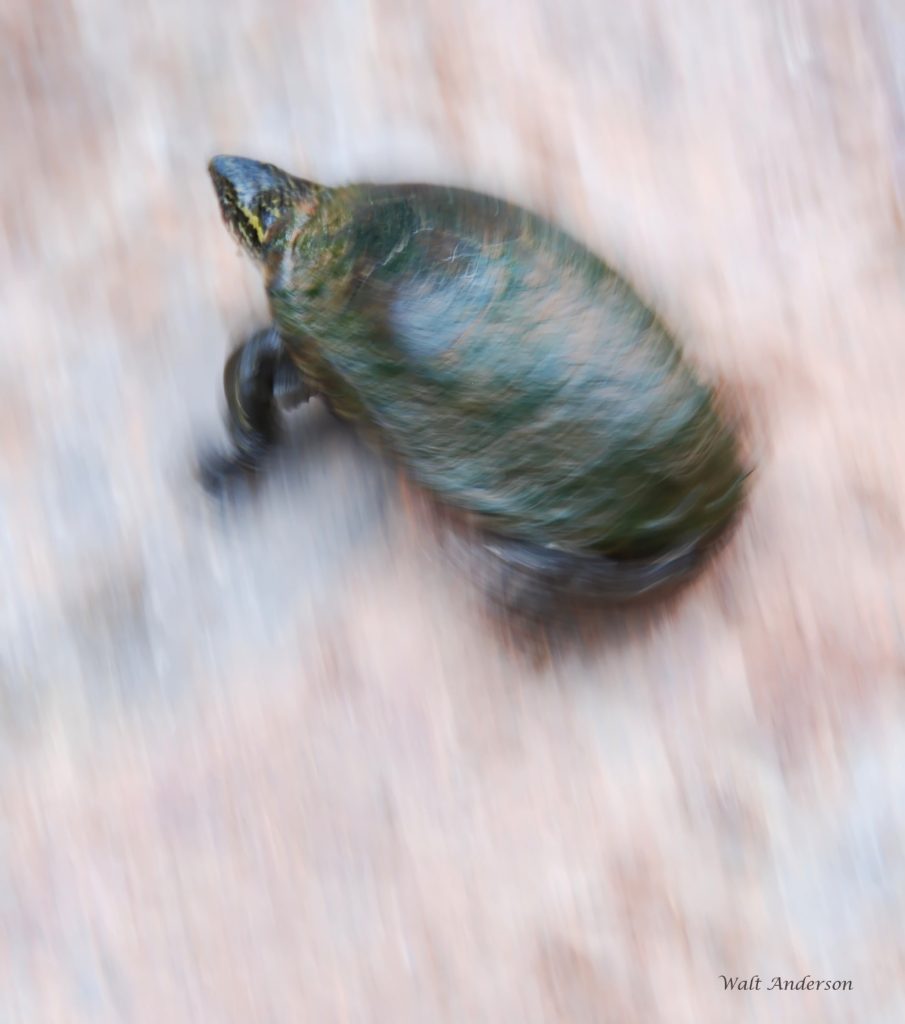
Though we know that Aesop’s tortoise outraced the hare, it was by persistence, not actual speed. Here I caught a native Sonoran Mud Turtle in action—it scutes along at a carapace. Punning aside, I like the effect of using a slow shutter speed and hand motion during the shot, though I admit it was a lucky accident.
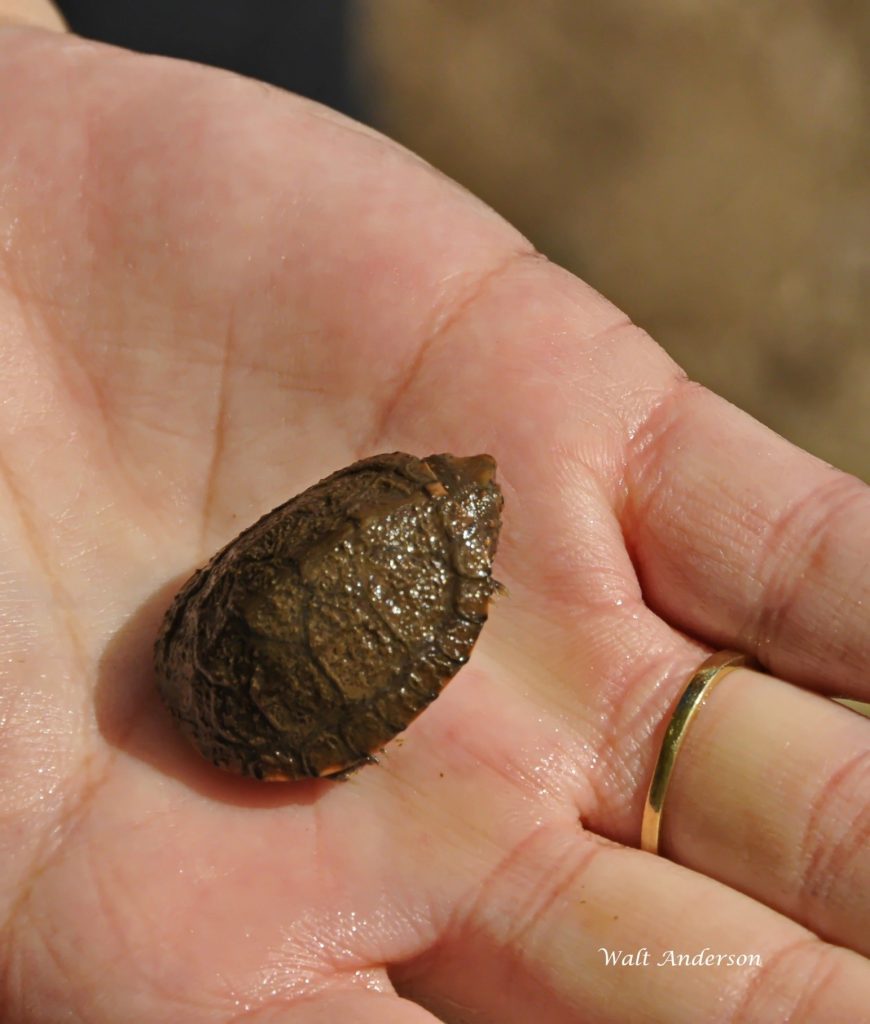
I taught Wetland Ecology and Management for many years at Prescott College, and as we tramped around in streams like the San Pedro and Verde Rivers, we would occasionally find Sonoran Mud Turtles like this baby. Note how the coating of algae makes quite effective camouflage.
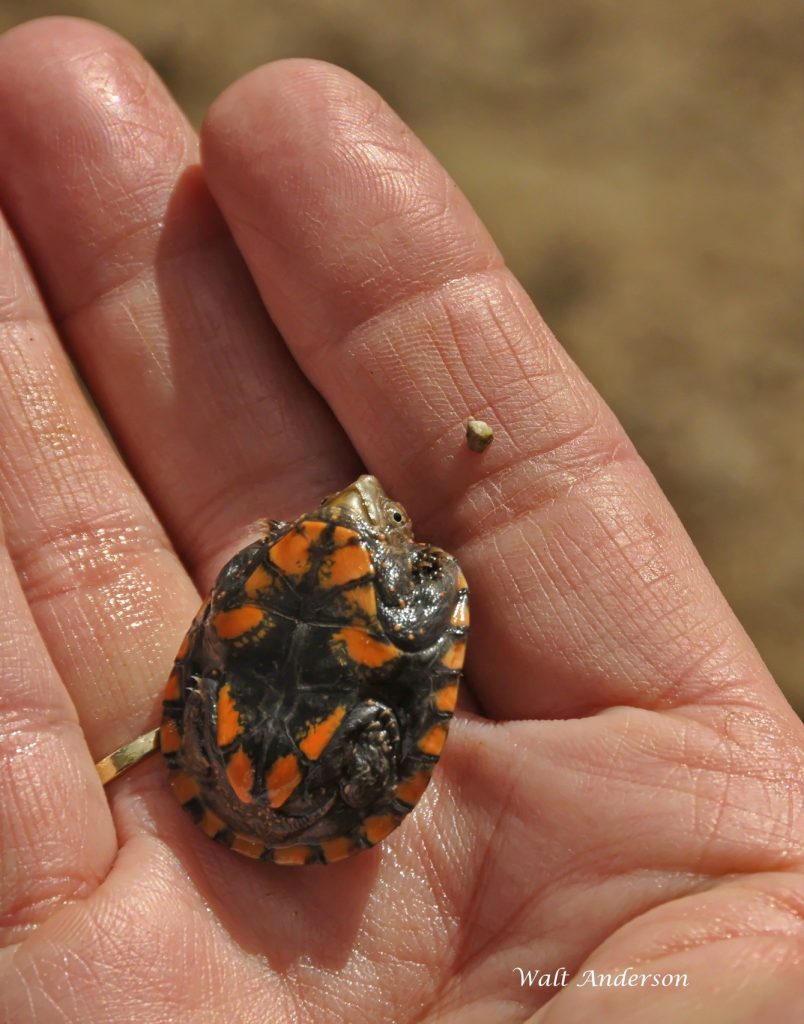
It’s time to turn turtle (the phrase that suggests helplessness as when a turtle ends up on its back). Now you can see the gorgeous colors on its plastron. Notice how its limbs are fully retracted; I do the same thing when someone throws me on my back.
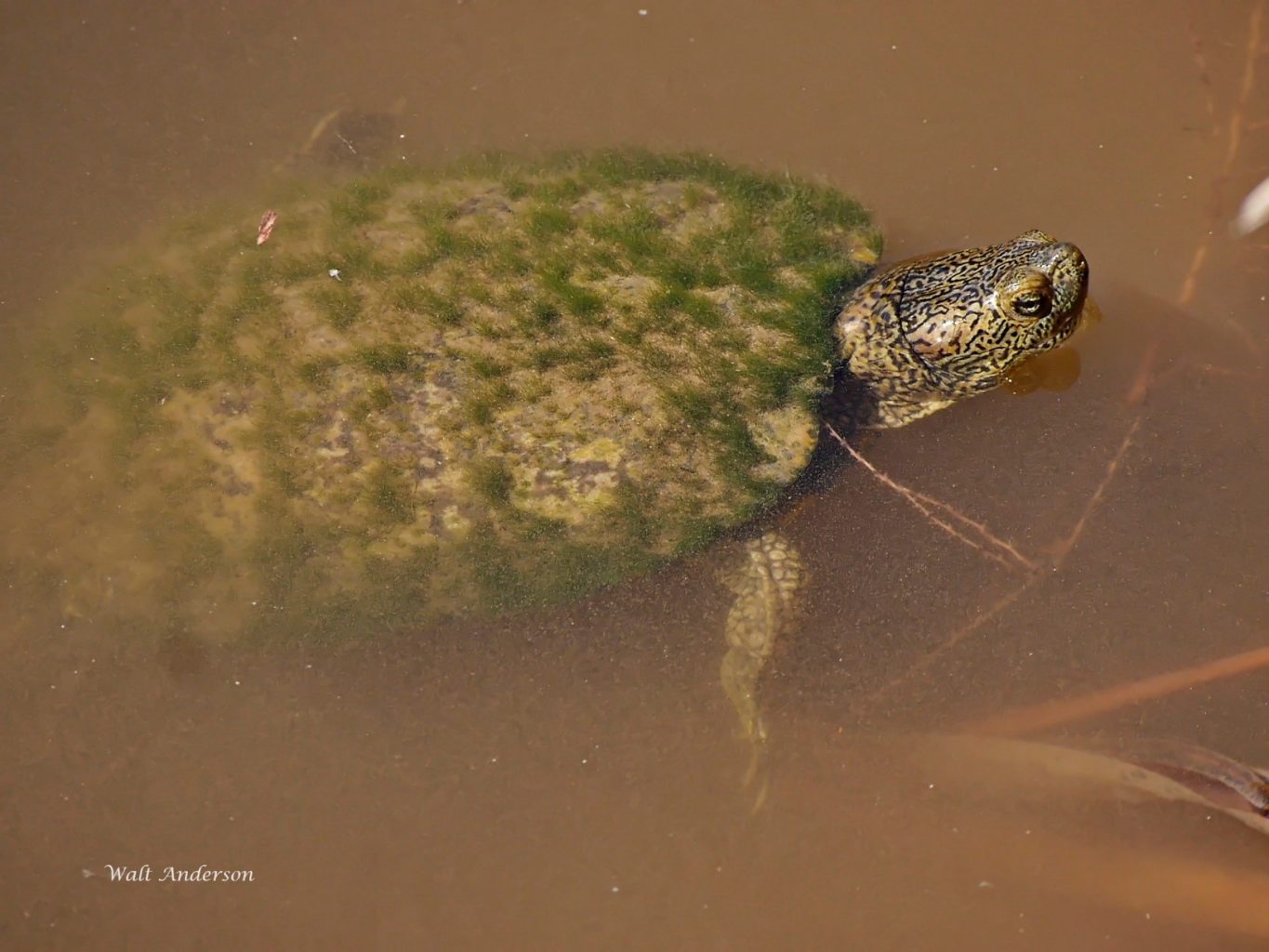
When I lived in Eugene, Oregon, we would sometimes see the Western Pond Turtle, a Pacific Coast species that has been negatively impacted by the spread of invasive Red-eared Sliders. Notice how the carapace has a coating of algae, probably good camouflage but a possible burden if it gets too thick.

The Red-eared Slider undergoes “ecdysis,” an annual shedding of the outer epidermis of the scutes. You can see that the rear turtle has smooth scutes while the one in the foreground is shedding. This prevents a build-up of algae on the backs of these turtles. Snakes also shed their skins as they grow, and sometimes you can find an intact shed. We shed skin cells ourselves, though we rarely notice it unless we have dandruff.
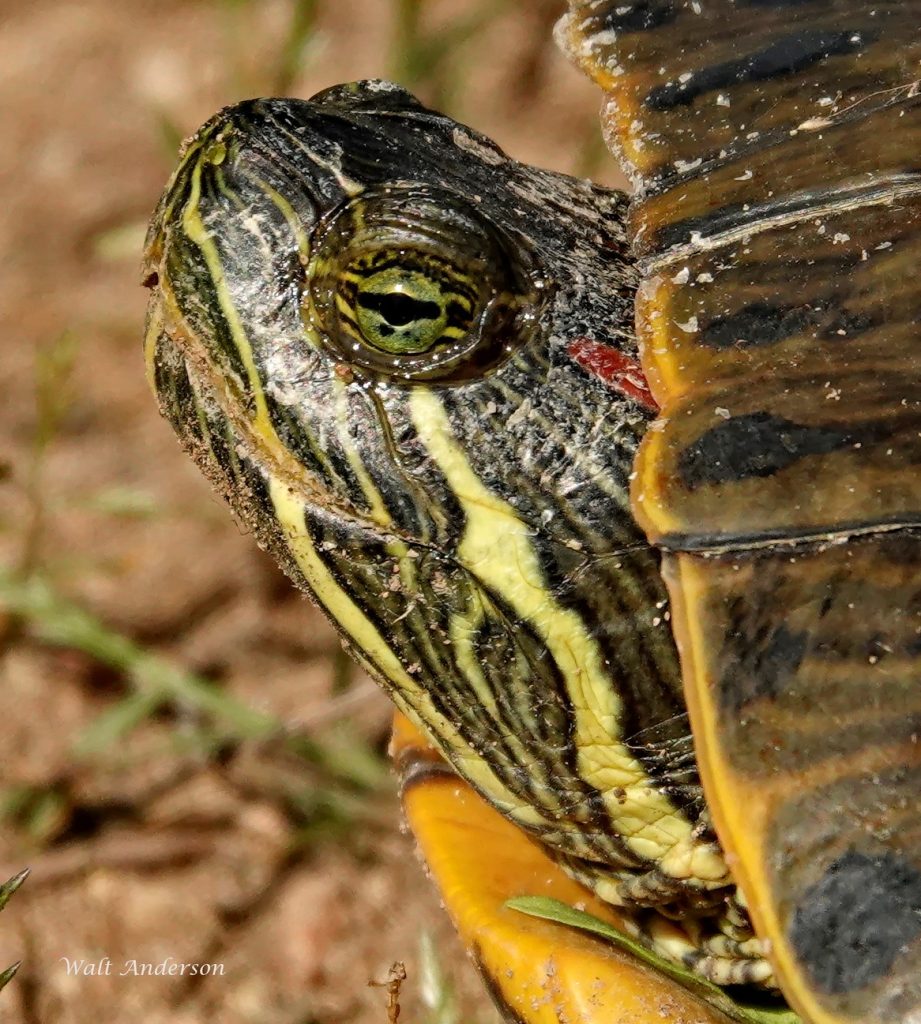
Our eyes have rods for light gathering and cones for interpreting color, but the Red-eared Slider puts us to shame by having 7 types of cones! While that doesn’t approach the many flavors of Baskin-Robbins, it’s impressive all the same. I can’t begin to imagine how a slider sees the world. Perhaps it’s a kaleidoscope of rich colors, like 512 individual Crayola crayons all at the same time. Who knows?
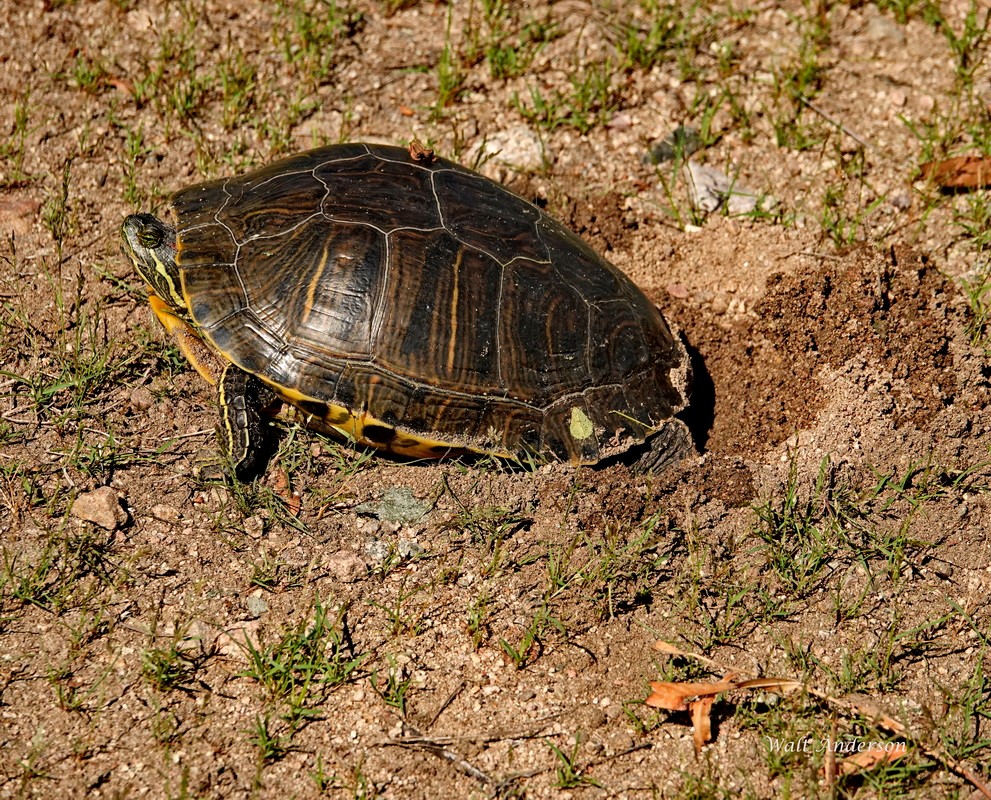
In mid-July, I was birding around the margins of Willow Lake in Prescott and came upon this Red-eared Slider digging her nest, where she will deposit up to 25 eggs, which will develop without female assistance for 2 to 4 months before the hatchlings appear. As long-lived animals (up to 20 years in the wild), sliders are in no rush to become sexually active; they start breeding at the age of 5 or 6 years. Females can store male sperm for well over a year, so the eggs are actually fertilized at the time of egg-laying. The sex of the hatchlings is determined by temperature during development. If the temperature during incubation is between 72-81 degrees F, the hatchling will be male; higher than that, it will be female (obviously the hotter sex). Global warming, of course raises concerns that males may become rarer and rarer. Those that make it will be raring to mate, for sure!
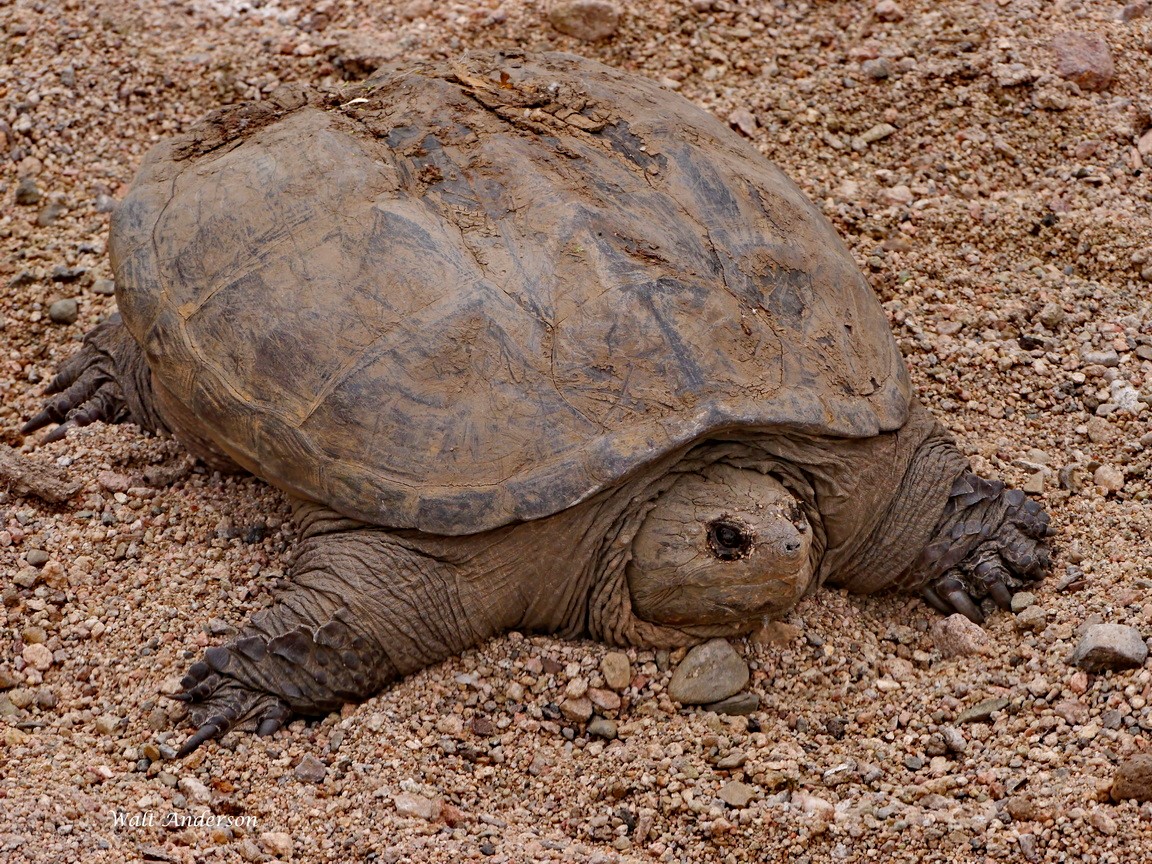
One day I was walking the dry bed of Granite Creek approaching Watson Lake. To my shock, here comes an enormous female Snapping Turtle, which my field guide describes as “ugly both in appearance and disposition.” What crazy fools released Snapping Turtles in a reservoir in central Arizona? They are native to most of the eastern US, but they surely don’t belong here, and I really wonder if anyone keeps them as pets. The females leave the water to lay their clutch of eggs, sometimes venturing as far as three miles from the water. Don’t mess with them, as they can lunge quickly and deliver a nasty bite. In the water, they are bottom feeders, but that should not be reassuring to swimmers—bottoms up!
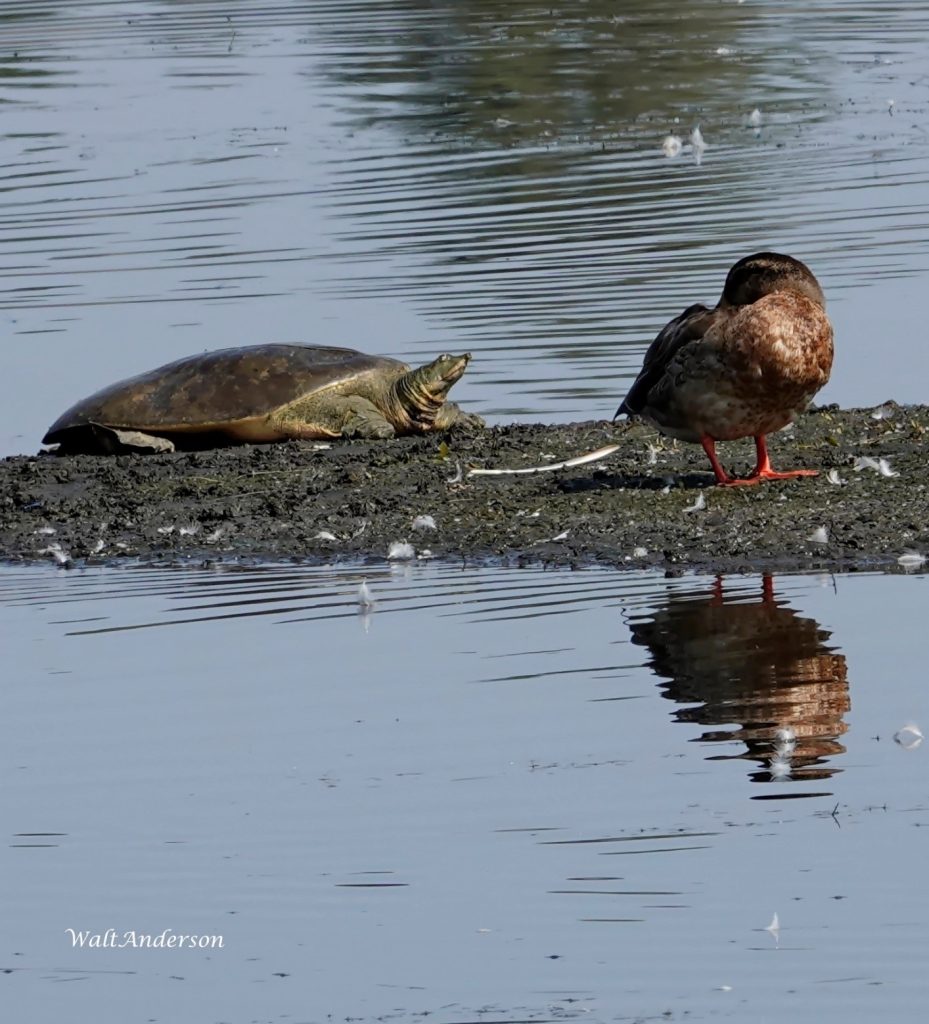
The other non-native turtle I sometimes see basking in local bodies of water is the Spiny Softshell, another species native to the eastern United States (there is a lot of water over there, you know, so turtle, frog, salamander, and fish diversity is extremely high relative to that in Arizona). Its shell is much flatter, enabling it to slide under the mud or silt more easily than for other turtles. Its foods in Watson Lake are likely crayfish, fish, and bullfrogs—all introduced species themselves! Let’s face it—almost all non-flowing (lentic or lacustrine) bodies of water in Arizona are unnatural. Shallow bodies like Willow Lake “aspire” to be marshes. Maintaining them for recreation and wildlife requires active management, as the City of Prescott is becoming more and more aware. Studies are now underway, and we need good science and wetland experience to avoid muddying the waters.

In an arid landscape, water creates oases upon which many species depend. Here the sliders are joined by Neotropic Cormorants, a species that has increased dramatically in Arizona in recent years, almost exclusively because of managed waters. Some of these human-created wetlands, like Watson and Willow Lakes, are now recognized formally as Important Bird Areas, and they bring in thousands of tourist dollars spent by sharp-eyed birders. Just ask Jay’s Bird Barn or Prescott Parks and Recreation Department about the economic value of wildlife-based recreation. But in Arizona, it all comes out in the wash. That is, pollutants head downstream, and nutrients accumulate in still waters.

Wildlife management today is all about human management. Our actions—poorly planned development, overuse of limited water supplies, introduction of invasive species, burning of fossil fuels, wastage of resources, releases of pollutants and toxins, on and on—are fouling our own nest. Part of it is the relentless quest to accumulate economic wealth at the expense of the wealth and health of the natural world. Part of it is basic lack of understanding of how nature works. We need better education and more accountable decision-makers now more than ever. This means that we cannot sit back passively and watch the world deteriorate. I hope that all who read these essays will step up as you can to join the citizen movements that stand up for people and nature simultaneously. Like any decent turtle, you have to stick your neck out to go forward.
